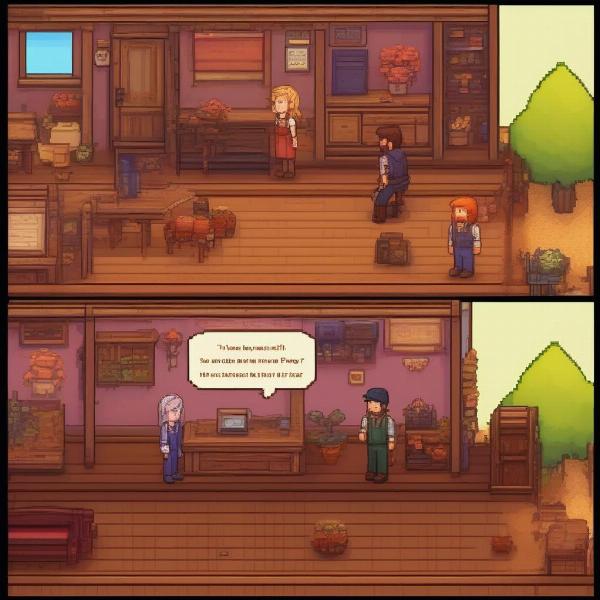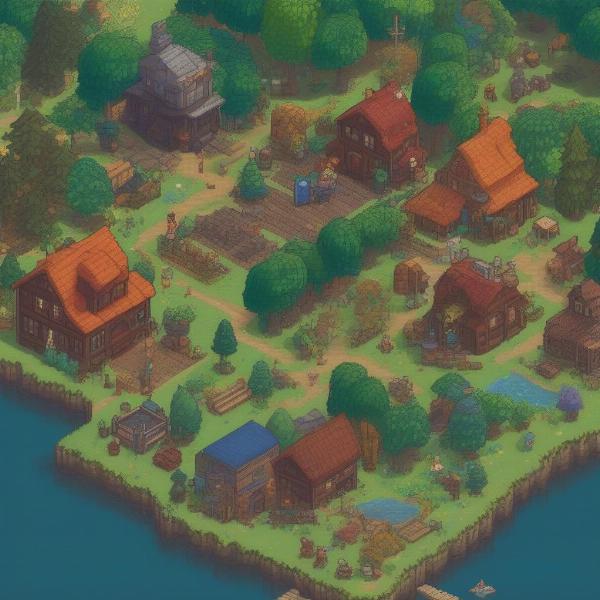Creating a game similar to Stardew Valley isn’t about replicating it exactly, but capturing its essence. It’s about blending engaging gameplay with a heartwarming atmosphere. It’s the satisfying loop of farming, fishing, mining, and forging relationships that keeps players coming back for more. So, how can you tap into this magic and create your own charming world?
Similar to choosing the right watering can for your crops, selecting the right game engine is crucial. Popular choices include Unity and Unreal Engine, both offering powerful tools and resources for indie game developers. There’s also GameMaker Studio 2, a more streamlined option perfect for 2D games and a great starting point for beginners. how to make indie games provides an in-depth look at the process of creating your own independent game.
Defining Your Core Gameplay Loop
What will be the heart of your game? Will it be farming, crafting, exploring dungeons, or a combination of these elements? Think about Stardew Valley’s core loop: plant, water, harvest, sell, repeat. Then, layer on social interactions, fishing, mining, and combat. Find the core activities that will keep players hooked and build around them.
Implementing Farming and Resource Gathering
Farming is a staple in games like Stardew Valley. Consider different crop types, growth cycles, and the impact of seasons. Resource gathering should extend beyond just farming. Think about mining for ores, foraging for wild plants, and chopping wood. Each activity should feel rewarding and contribute to the overall gameplay loop.
Crafting a Compelling Narrative
While a deep story isn’t essential, a charming narrative can significantly enhance player engagement. Stardew Valley successfully weaves together simple yet effective storytelling through character interactions and town events. Give your NPCs personality and backstories. Create festivals and events that bring the town to life. Even small details can add depth and meaning to the player’s experience.
Building Relationships and Community
Stardew Valley thrives on its sense of community. Implementing a robust relationship system where players can build friendships and romantic relationships with NPCs adds another layer of depth. Consider dialogue options, gift-giving mechanics, and even the possibility of marriage and starting a family.
 Stardew Valley Inspired Farming System
Stardew Valley Inspired Farming System
Choosing the Right Art Style and Music
The art style and music are crucial for creating the right atmosphere. Stardew Valley’s pixel art and relaxing soundtrack contribute significantly to its charm. Consider your game’s tone and choose an art style that reflects it. Whether it’s pixel art, hand-drawn graphics, or 3D models, ensure it’s consistent and appealing. The music should complement the gameplay and enhance the overall experience.
Designing Your World
Creating a believable and engaging world is essential. Think about the layout of your town, the different environments players can explore, and the overall aesthetic. Don’t be afraid to get creative and add your own unique touches. Just remember to keep it consistent with your game’s core theme and gameplay mechanics.
Technical Considerations for Game Development
Choosing the right game engine is the foundation of your project. Consider factors like ease of use, performance, and platform compatibility. Understanding programming languages like C# for Unity or C++ for Unreal Engine is crucial for bringing your vision to life.
Programming and Scripting
Learning the basics of programming can seem daunting, but it’s an essential skill for game development. Start with tutorials and online resources. Focus on understanding the fundamental concepts before tackling complex features. Remember, even small progress is a step in the right direction.
 Building Relationships in Your Game
Building Relationships in Your Game
Polishing Your Game and Preparing for Launch
Testing your game thoroughly is crucial for identifying and fixing bugs. Gather feedback from playtesters and iterate on your design based on their input. Once you’re satisfied with the quality of your game, it’s time to think about launching on platforms like Steam, Itch.io, or mobile app stores. Knowing how to market your game effectively can make a big difference in its success. Creating a strong online presence and engaging with your community can help you build a loyal following.
Marketing and Community Building
Think about engaging with potential players, building excitement for the release, and collecting feedback after the launch. Just like in Stardew Valley where nurturing relationships leads to a richer experience, cultivating your player community is key to a game’s long-term growth.
Expanding Your Game with Post-Launch Content
Consider adding new content, features, and even expansions to keep players engaged long after release. This could include new areas to explore, new characters to meet, or even new gameplay mechanics. Regular updates can keep your game fresh and exciting, fostering a thriving community. Learning about game saving mechanisms will be invaluable as your game expands. For some tips on saving game data, see how to save game stardew valley.
 Creating an Engaging Game World
Creating an Engaging Game World
Frequently Asked Questions
1. What are some good game engines for beginners? GameMaker Studio 2 is a great option for 2D games.
2. What programming languages are used for game development? C# (Unity) and C++ (Unreal Engine) are common choices.
3. How important is storytelling in a Stardew Valley-like game? A charming narrative enhances player engagement.
4. How can I market my indie game effectively? Building an online presence and engaging with your community is key.
5. What is the key to making a successful farming simulator? A satisfying core gameplay loop and a charming atmosphere are essential.
6. How can I create a sense of community in my game? Robust relationship systems and engaging town events help foster community.
7. How can I add longevity to my game after launch? Regular updates with new content and features keep players engaged.
Conclusion
Creating a game like Stardew Valley is a challenging but rewarding endeavor. Remember to focus on creating a captivating core gameplay loop, building a charming world, and fostering a strong sense of community. With dedication and creativity, you can bring your own unique vision to life and create a game that players will cherish. So, take inspiration from Stardew Valley, but don’t be afraid to forge your own path and create something truly special. Remember, the most important ingredient is passion.

